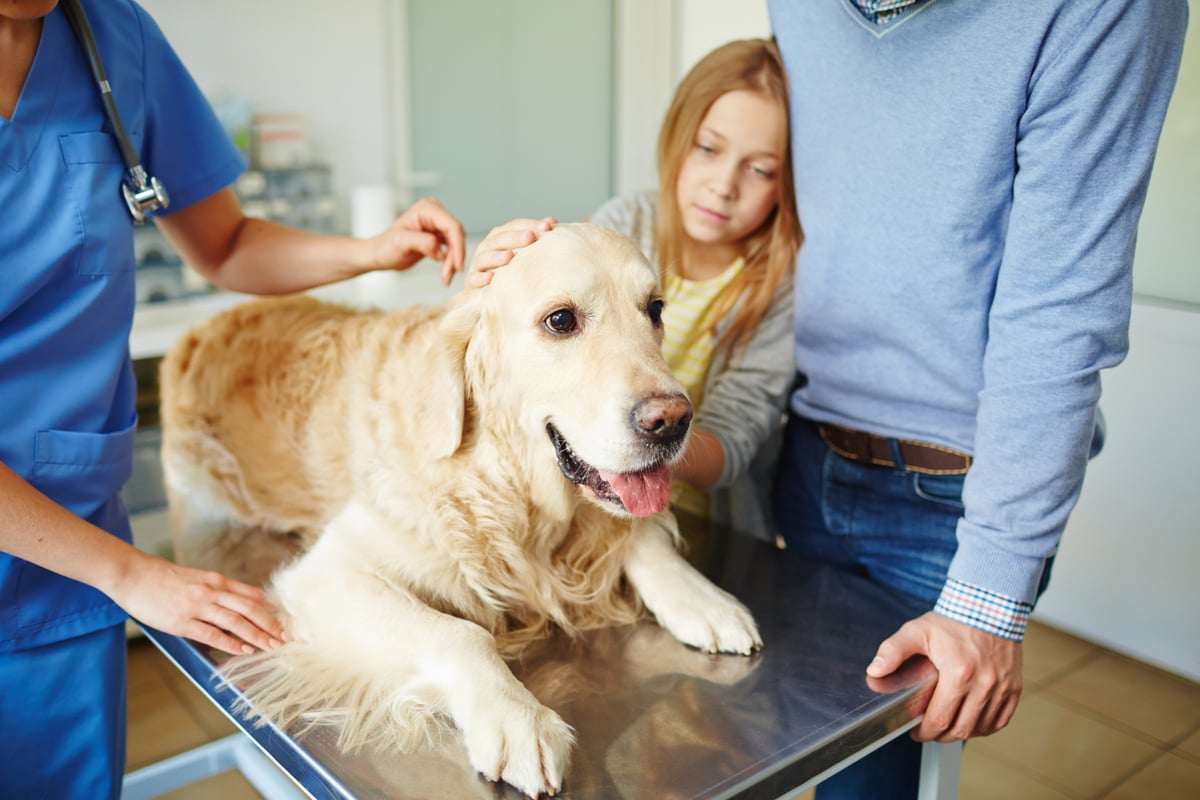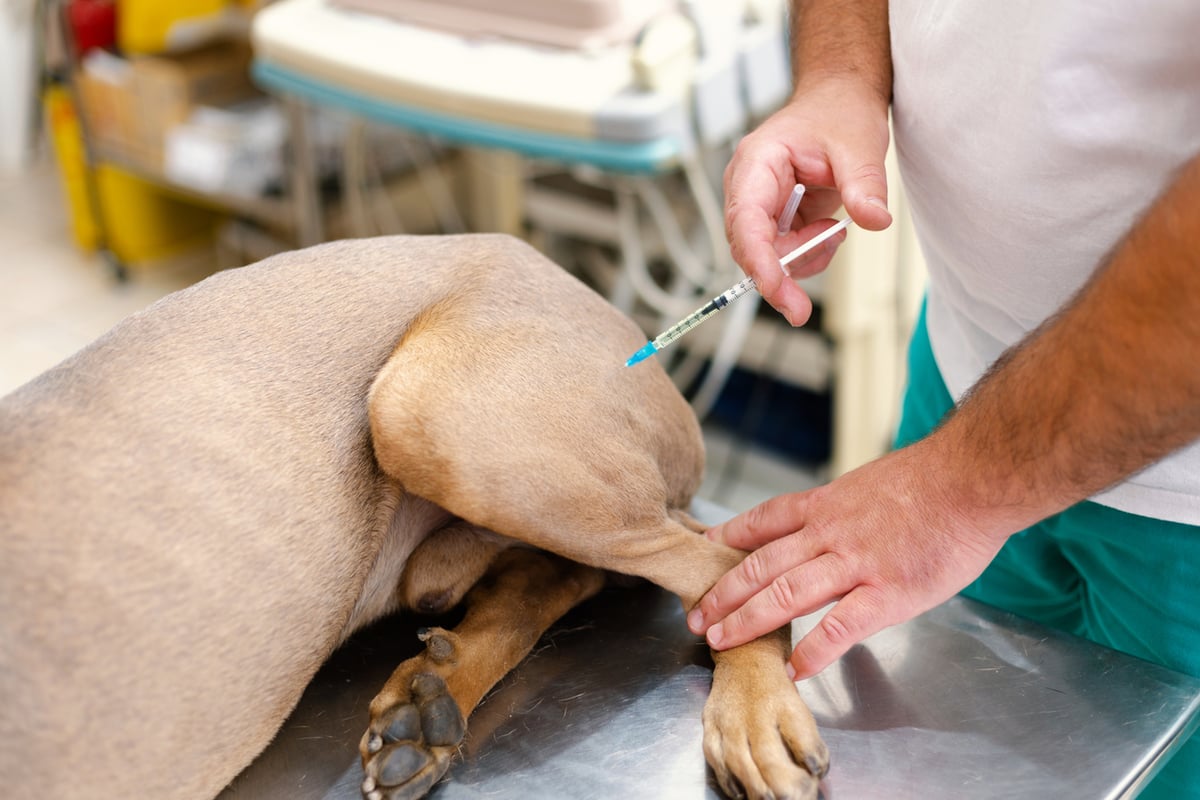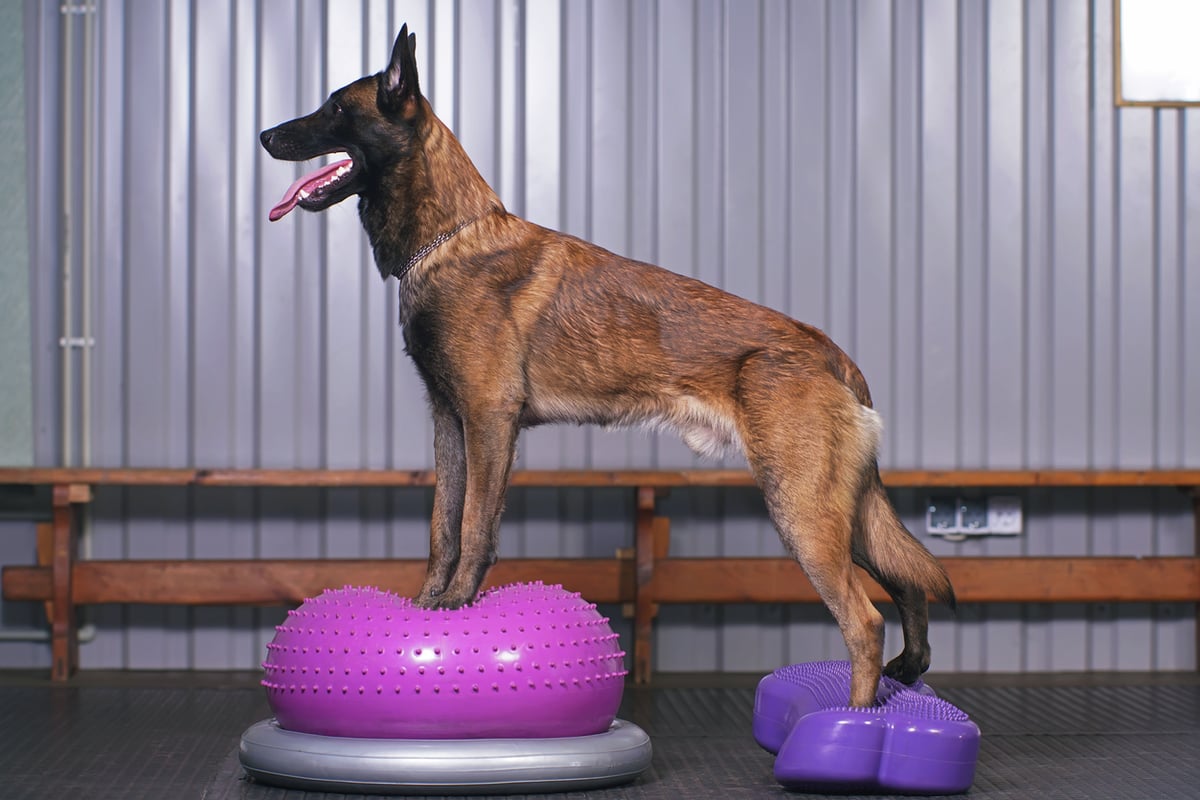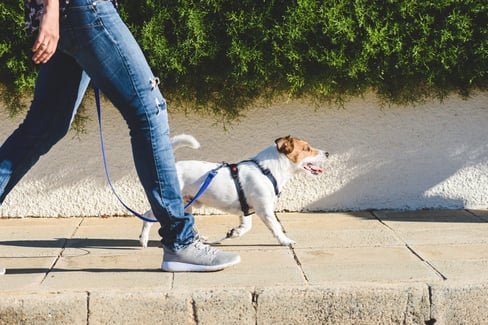Table of Contents
Paralysis can be a scary experience for your dog, and it can also be very stressful for you, too— especially if you don’t know what to do or what to look for.
You just don’t want your poor pup to be in pain for any longer than absolutely necessary.
In fact, you want to do everything possible to help your furry friend recover from a dog paralysis back legs condition. In this post, we are going to share how to identify when your dog loses use of back legs temporarily, some tipsthat will help you care for your dog during dog paralysis back legs recovery, as well as ways to prevent future paralysis and stiffness episodes.
Dog Sudden Paralysis Back Legs Symptoms
If your dog loses use of back legs temporarily and unable to walk, stand or move, it could be a sign that his hind legs are paralyzed.
‘Dog paralysis back legs’, also known as a hind leg paralysis (what we refer to as paraplegia in humans) can happen when there is any damage to the spinal cord and results in partial or total loss of movement below the affected area of the spine. This can range from mild stiffness and discomfort to severe paralysis.
Watch for the following symptoms in a spinal injury dog back legs:
- Joint of the affected leg cannot be flexed
- Affected leg is unable to bear weight
- Seems to be in pain
- Lame dog or limping
- Sudden weakness
- Gait abnormality
- Shifting weight between limbs to reduce pain
- Dragging the limbs
- Dog stiff back legs
- Dog back legs paralyzed
If you notice that your dog has lost control over their back legs, even in the slightest, take them to the vet immediately because it could be a sign of something very serious.
Dog Paralysis Back Legs Diagnosis
Nerve root damage in the tailbone or lower back can cause hind leg paralysis and nerve damage in the tibial, femoral, peroneal, or sciatic nerve in the affected leg.
When your vet checks for a spinal injury, they will examine:
- Which leg and where the pain comes from
- Muscle strength to determine where the injury occurred
- Their posture
- Their gait
- Spinal reflexes, using testing exercises
Basically, the closer a nerve injury is to its target muscles (in this case, dog back legs), the better the chances the dog will have at recovering well. So, that's why it's so important for your vet to determine where the injury to the spinal cord is located to give you the most accurate information about your dog's injury and dog paralysis back legs recovery chances.
Additionally, the vet will want to know whether there was any trauma, as trauma can cause temporary problems the same way an injury can cause permanent ones depending on the area that was affected and how. The best thing to do is to provide all the details possible before deciding whether surgery or further examination. Don’t be afraid to ask questions and discuss your options with your vet.
Causes of Dog Stiff Back Legs
We all know dogs are special. They love us unconditionally and are always there for us, no matter what we have going on in our lives. But nothing is scarier than seeing your pup experience sudden dog health issues. Especially if your dog is experiencing sudden stiffness in their legs or other body parts.
You might notice your dog sleeps on the side with legs straight out and stiff.
This is often accompanied by pain and may even prevent them from being able to walk or move at all. However, there are many different causes of this problem, and knowing the causes can help you get your dog the help they need faster.
We will cover some of the most common causes of dog back legs paralysis so you can keep an eye on your pup for any sudden changes and get them back to normal.
Dog Arthritis
Dog arthritis is a common cause of dog paralysis in back legs and sudden stiff legs in dogs. This degenerative disease affects your dog’s joints as they age, resulting in painful symptoms that can lead to dog sudden stiff legs. When the cartilage wears down at the joint more quickly than the body can produce it, arthritis occurs, along with painful joint inflammation.
Without any cartilage to cushion the bones and joints, bones rub together, leading to painful and swollen joints. This is not only uncomfortable for your pup, but in some places in their body, it can lead to mobility problems and even dog sudden paralysis back legs.
This is especially true of spinal arthritis. Spinal arthritis wears down the vertebrae over time and can cause bone spurs around nerves leading to paralysis in the back legs. This can make movement painful and impossible as the joints become inflamed and sore.
The good news? This condition’s effects can be slowed down by feeding your pup a supplement that targets pain, joint degradation, and swelling without the potential side effects that come with painkillers.
Ingredients that help reduce pain from stiff dog legs include:
- Glucosamine for dogs
- Chondroitin
- MSM
- Hyaluronic acid
When looking for a dog supplement, look for one that contains 100% active ingredients and no fillers, like TRI-ACTA H.A., for effectively treating and managing existing dog arthritis.
TRI-ACTA H.A. for Pets
Our maximum strength formula is optimally designed to accelerate the formation of cartilage, minimize inflammation, expedite the healing process, and improve joint conditions.

Spinal Injury Dog Back Legs 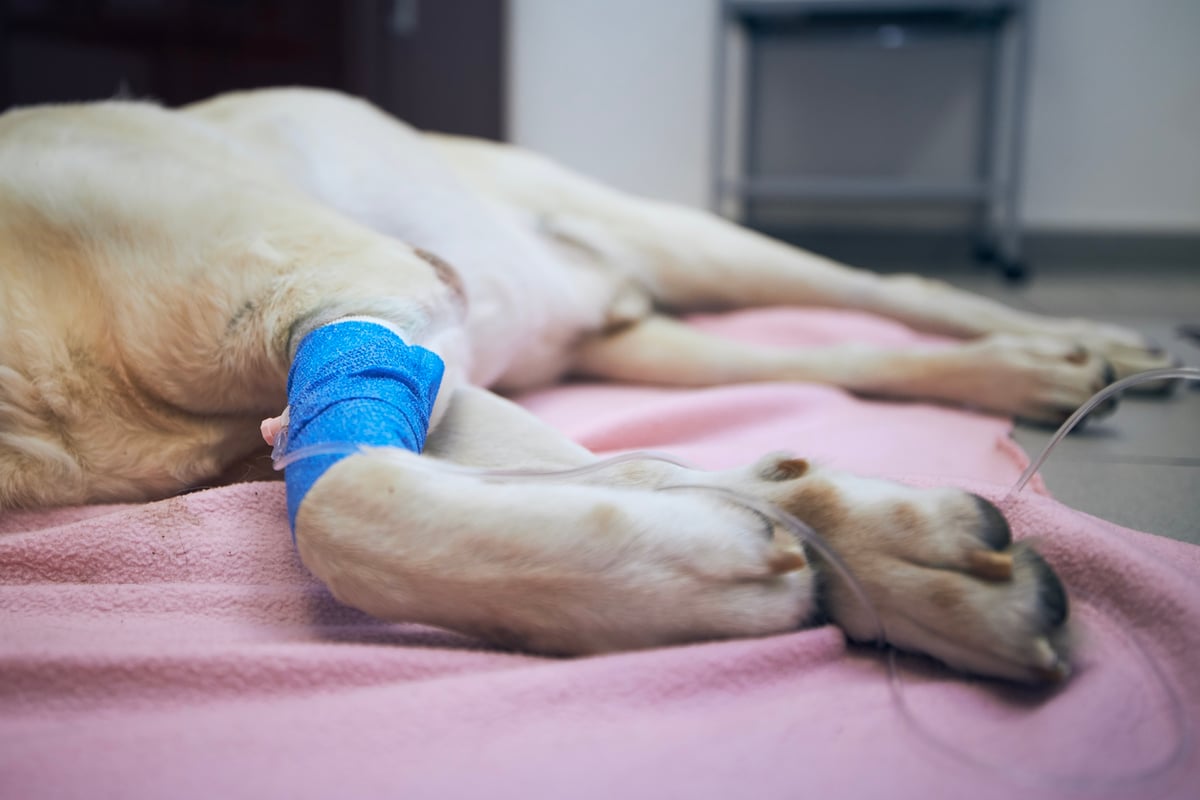
A spinal injury can occur from falls, car accidents, or other trauma. Typically, these accidents can cause the herniation of a disc in the back, which leads to the injury of the spinal cord in dogs.
Spinal injury dog back legs can be caused by:
- Dislocation
- Compression
- Fracture
- Impact (such as being hit by a car)
- Laceration
Paralysis may not be the first sign of a dog back leg injury. You may notice things like limping and lethargy before you notice anything sudden.
The following can be initial signs of dog back legs paralysis:
- Arching of the back
- Pain when the back is touched
- Inability to move hind legs
- There is no sensation or feeling of pain below the injury site
- Back leg muscles are softening
- Neck pain
- Inability to turn the head
- Leg weakness
- An abnormal dragging of the feet
- Lifting one leg up
Although your dog may have moderate pain at first, they might still be able to get around just fine. This can make it tricky to spot the severity of the injury, especially if your dog is acting like their normal self. The thing is, the condition may progress to paralysis over time and cause further damage. That’s why it’s important to take your dog to the vet if there are signs that they have dog stiff legs, regardless of how they have been acting.
Tumor
Unfortunately for our canine friends, they are not immune to the pains of cancer and tumors that humans can experience.
Dogs with back legs paralysis can exhibit chronic, often painful lameness or weakness of the front or hind legs caused by a tumor that affects the nerves. Tumors can be identified using computed tomography (CT) or magnetic resonance imaging (MRI) scans. Surgical removal or biopsy of the tumor is necessary to determine the diagnosis and the chance for dog paralysis back legs recovery.
Nerve sheath tumors are common in dogs and often affect multiple nerves. These tumors are difficult to completely remove, even with limb amputation. Tumors can also affect other parts of the back and dog spine, leading to dog back legs paralysis.
Radiation therapy may be helpful, but the outlook for recovery can be poor. Treatment and care for your dog will mostly focus on making your pup feel as comfortable as possible.
Degenerative Myelopathy
Degenerative myelopathy, sometimes called chronic degenerative radiculomyelopathy, causes hind limb weakness and paralysis as the spinal cord deteriorates. Symptoms are caused by degeneration of the spinal cord's white matter, which conducts, processes, and transmits nerve signals.
Degenerative myelopathy is similar to some of the forms of human amyotrophic lateral sclerosis (ALS), more commonly known as Lou Gehrig’s Disease. It can look like osteoarthritis at first but progresses to worsening weakness and ataxia (wobbling and stumbling), distinguishing it from osteoarthritis of the hip joints.
There isn’t a clear cause of this condition, but it seems to affect older and middle-aged dogs of certain breeds that carry a genetic predisposition thanks to a gene known as SOD-1.
Breeds with the SOD-1 gene include:
- German Shepherds
- Siberian Huskies
- Collies
- Bernese Mountain Dog
- Boxers
- Chesapeake Bay Retrievers
- Golden Retrievers
There is no clearly effective treatment for this condition at the moment, so your vet’s focus will be on clinical management making your dog as pain-free as possible. Supporting the joint structures as this progresses is also important, so adding a supplement like TRI-ACTA for pets can be beneficial.
TRI-ACTA H.A. for Pets
Our maximum strength formula is optimally designed to accelerate the formation of cartilage, minimize inflammation, expedite the healing process, and improve joint conditions.

Environmental Exposure
Sometimes there are things that can be in your dog's environment that can be dangerous to them and even cause dog back legs paralysis.
Things like fungus they ingest in your backyard, or even ticks that can bite them and cause a painful, paralyzing reaction for your pup.
Immediately remove your dog from a toxic environment if you suspect it is unwell as a result of exposure to an environmental toxin. Your veterinarian will likely run a series of tests on the animal to determine what kind of toxin was involved and its severity.
Some common toxins that cause paralysis include those outlined in the table below.
| Environmental Cause of Dog Paralysis Back Legs |
What It Is |
| There are a number of different species of Aspergillus fungi found in soil worldwide that cause Aspergillosis infection in dogs. It enters the dog's respiratory tract and then travels to the bloodstream and all over the body. As a result of this fungal infection, the dog's organs, muscles, and bones deteriorate, eventually leading to paralysis. While treatment has been successful in rare cases, the prognosis for dogs with disseminated aspergillosis is poor. |
|
| s caused by a protozoan parasite called Neospora caninum. It is possible for dogs to become infected by eating contaminated food and water. It can also be transferred from a mother to a fetus in the womb. Infections in young puppies usually lead to partial paralysis of the legs, particularly the hind legs. The paralysis is often progressive and results in rigid contracture of the muscles. Symptoms such as ataxia and inflammation can also occur in adult dogs affected by this condition. |
|
| A toxin in the tick's saliva attacks the nervous system and causes tick paralysis, a rapidly progressive motor paralysis. Affected dogs may demonstrate changes in their voices, lack of coordination of their hind legs, breathing changes, gagging, coughing, vomiting, dilated pupils, and eventually paralysis. In most cases, symptoms appear 3 to 9 days after the tick attaches. The tick should be removed as soon as possible, and your dog should be treated with canine tick hyperimmune serum to avoid serious outcomes. |
|
| Paralysis in dogs is caused by botulism, a rare condition. The toxin produced by the bacteria Clostridium botulinum is responsible for botulism. In most cases, dogs get botulism from eating dead animals or raw meat that has been contaminated. After ingesting contaminated meat, botulism symptoms usually appear hours to days later, though they can be delayed as much as six days. It often starts with weakness in the rear legs, which progresses to the front legs, the head, and facial muscles within 24 hours. If you spot symptoms early, you can offer your dog botulinum antitoxin and avoid serious neurological outcomes. |
|
| You can find organic phosphates in a wide range of insecticides, from lawn chemicals to flea and tick treatments. These chemicals disrupt the nervous system, lower heart rates, and cause muscle tremors and paralysis in insects, but if dogs are exposed, they will suffer the same consequences. Acute symptoms, including paralysis, can onset within 24 hours, while other symptoms, such as muscle wasting and decreased heart rate, may take up to 2 weeks to onset. Your dog will need to be admitted to the animal hospital for treatments, including IV fluids and other medications designed to reverse the symptoms of the exposure. |
Causes of Dog Sudden Stiff Legs
Think about when you have sudden pain or stiffness in your neck or back and automatically assume it might be a pinched nerve. Similar occurrences can affect our pooch when we notice our dog loses use of back legs temporarily.
Dog sudden stiff legs are usually caused by an injury to the nerve roots in specific locations of the body. Trauma is the most common cause of dog sudden paralysis back legs.
The chart below compares the body parts subject to nerve damage in dog paralysis:
| Dog Sudden Stiff Front Legs |
Dog Suddenly Stiff Back Legs |
|
|
Signs of Dog Paralysis in Back Legs and How to Avoid Further Injury
When a dog’s legs are stiff or possibly paralyzed, there are certain things to do and others to avoid to prevent the dog paralysis back legs worsening or causing more discomfort.
Follow the suggestions listed below for how to help dog with stiff back legs.
Wobbling During Walks
If you notice your pup wobbling during walks, you’ll likely want to consider a dog temporary paralysis back legs treatment option.
The top dog back legs weak and shaking treatments are:
- Prednisone medication
- Joint supplements
- Surgery
- Physiotherapy
- Weight loss
Consider a dog hip brace for paralysis back legs recovery if the cause is due to hip pain, or a similar orthopedic brace designed for the legs.
Difficulties in Walking and Standing
Many factors can cause difficulties in walking and standing for your dog. Infections that appear near the face or in the ears can spread to muscles, nerves, and vital parts of the body. If left untreated, an infection can cause front and hind leg paralysis.
Pain
Aside from difficulty standing and walking, your dog may also show signs that they are in pain. Yelping, whining, and refusing to put weight on the affected area are all signs that your dog may be suffering.
If your pup experiences pain during their dog back legs paralysis recovery, you want to limit exercise and activity to allow the nerves to heal.
Other home remedies to help pain from dog back leg paralysis include:
- Applying heat
- Massaging the area
- Stretching the tendons
- Wrapping the limb in a light bandage
Partial or Full Paralysis
Dogs who suffer from partial or full paralysis may benefit from simple modifications to their environment. In addition to a healthy diet and implementing supplements, consider making the following changes to help your pup live more comfortably during their dog paralysis back legs recovery:
- Create a small area with shallow, soft, comfortable bedding
- Carry your dog outside to the bathroom
- Place food bowls close to their bed
- Limit walks to ten minutes per day
- Consider purchasing ramps for areas your dog likes to go, such as the couch or your bed.
Swelling
If your pup experiences swelling due to their dog back legs paralyzed, your vet may precribe a non-steroidal anti-inflammatory drug (NSAID) to treat the inflammation. Alternatively, you can consider animal supplements with MSM, a potent natural anti-inflmmatory.
Extra Body Weight
In some cases, obesity can contribute to dog back legs paralysis. When your dog has extra body weight, it makes them more prone to injuries like herniated disks. You can manage symptoms and prevent injuries by maintaining a healthy weight with a calorie-restricted diet and regular exercise.
Less Muscle Mass
Muscle atrophy, or muscle loss, is the deterioration of muscle tissue due to aging, illness or lack of physical activity. Old dog stiff back legs could be due to the natural loss of muscle mass that comes with aging. Switching to senior dog food that’s lower in calories and high in protein can help combat dog back leg paralysis from less muscle mass.
Fatigue
With dog paralyzed back legs often comes fatigue. This may be lethargy due to pain or discomfort when moving, or fatigue could be due to a virus or infection. If your dog shows signs of extreme fatigue, it is important to get examined by a veterinarian who can prescribe antibiotics or another medication.
Dog Stiff Legs Treatment Options
Paralysis in dogs is a serious condition that can lead to complications and the loss of mobility for your dog. A dog's legs can be paralyzed due to illness or injury, but no matter the cause, it's important to seek veterinary care immediately after noticing any symptoms so they can be diagnosed and treated as soon as possible.
Depending on the type of dog paralysis back legs you are facing, there is an appropriate treatment out there. We’re going to cover the most common ones here so you can get a broad idea of the options available to your sore, stiff pup.
Treatment Option #1: Joint Supplements
Best for Treating: Dog Arthritis and Dog Stiff Back Legs
Sometimes, if your dog has only a mild to moderate case of dog stiff back legs, it can be a sign they are aging and facing dog arthritis. Dog arthritis can take years to onset or may happen quickly, leaving you with dog sudden stiff legs.
One treatment that may be most helpful to these situations is both affordable and accessible to pet parents, so you can take action ASAP. Dog joint supplements. These powerful products are designed to combat the signs and symptoms of arthritis. They often feature common ingredients like glucosamine and chondroitin to help repair and protect cartilage from the deterioration caused by arthritis.
The thing is, not every glucosamine for dogs supplement is created equally. You need to make sure you are doing your homework on the ingredients and how they benefit your pup.
Here are a few tips for selecting a quality dog stiff back legs supplement:
- Look for a supplement that contains as few fillers (zero being preferable) as possible to avoid overpaying for an ineffective supplement
- Look for a supplement that is vetted by third parties like Health Canada
- Look for a supplement with a small, concentrated serving
- Look for a supplement with high-quality, pharmaceutical-grade components
One supplement that checks off all those boxes? Integricare’s TRI-ACTA for pets. Offering help to both dogs and cats in your home, this product is perfect for preventative care and dogs with early signs of mobility issues. And when they get older or mobility concerns worsen, you can switch to our extra strength TRI-ACTA H.A. for pets. This extra-strength formula has the addition of hyaluronic acid to help reduce pain and other symptoms while treating arthritis — which leads to those awful stiff back legs.
TRI-ACTA H.A. for Pets
Our maximum strength formula is optimally designed to accelerate the formation of cartilage, minimize inflammation, expedite the healing process, and improve joint conditions.

Treatment Option #2: Prescribed Medication
Best for Treating: Injuries and Infections
Sometimes, the only option for treating severe trauma or fighting the effects of a toxin like Botulism, you need to bring in the big guns – and by that, we mean your veterinarian and prescription medication.
Whether it is for reducing pain and inflammation caused by severe trauma (like a run-in with a car) or to treat an infection, your vet can sometimes recommend a medication to treat the symptoms your pup is experiencing, including dog sudden paralysis back legs.
Several medications may be used to treat dog back legs paralysis, including:
- Antibiotics
- Painkillers
- Antitoxins
- Antifungal medications
You should always follow the instructions on the label when administering medication to your pet. If you have any questions about administering it properly, consult your veterinarian for guidance. Side effects of these medications include vomiting and diarrhea in some dogs. Your vet will be able to let you know whether there are any other possible adverse reactions that may occur when giving a particular drug to your dog. If so, they will advise what precautions should be taken while your pup is on the medication.
Treatment Option #3: Radiation
Best for Treating: Tumours
Radiation therapy is a treatment option for dogs with a tumor that is causing paralysis. This treatment helps your dog get back to its old self by shrinking the size of the tumor that is causing painful, debilitating symptoms for your dog. It may be preferable to surgery for a few reasons. Surgery for a spinal tumor can be complicated based on the location of the tumor and may only be an effective treatment if the tumor can be completely removed without affecting the spinal cord's function. Even then, it is significantly more invasive for your pup and may lead to long recovery times.
Radiation therapy for dog paralysis back legs comes in two types:
- Conventionally fractionated radiation therapy (CFRT)
- Stereotactic radiation therapy (SRS/SRT)
The differences between these two types of radiation treatment for a dog with paralyzed back legs are outlined in the table below.
| Type of Radiation for Tumour Treatment |
Description |
| Conventionally Fractionated Radiation Therapy |
CFRT can treat tumors in a way neither surgery nor chemotherapy can. A lengthy course of treatment and multiple anesthetic episodes are required, which may be disadvantages for some pet parents. |
| Stereotactic Radiation Therapy |
A more modern technology, SRS/SRT delivers high doses of radiation with sub-millimeter precision, effectively destroying tumors with minor unwanted damage to healthy tissues. It also requires fewer treatment sessions and fewer side effects during recovery. |
Your vet can direct you to the best option for your dog's specific needs and help reduce their pain and dog back legs paralysis symptoms as best they can.
Dog Stiff Back Legs Recovery Tips
Let’s get into the top three tips for helping your dog’s paralysis back legs turn into a recovery prognosis!
Tip #1: Stay Active
Keeping your dog active is important for their overall health, but it can be especially helpful for dogs with stiff back legs.
It helps to avoid obesity so that the weight placed on the joints and the back legs is not as great, therefore reducing the strain on your pup's joints. It also helps keep muscle tone and strength intact, allowing your dog to build strong and supportive internal structures. Good exercise habits may also help relieve pain, improve joint and muscle health, and aid the rehabilitation of pets following an injury, disease, or surgery.
Here are a few things to keep in mind when exercising during dog stiff back legs recovery:
- Gentle, slow walks are good for stretching and strengthening legs.
- Start low and slow, and work up slowly to more strenuous work if your dog is recovering from an injury.
- Keep recovering dogs on a shorter leash to make sure they don't get excited and jump up, potentially causing more injury to their back legs
- Walks in your backyard or in quiet places with few distractions may be ideal for those extra excitable pups who want to play with other dogs but could injure themselves further by doing so
You should also always work with your vet to create a plan to help your dog stay active and work up to more regular activities to avoid overdoing it.
Tip #2: Try Alternative Therapy
Sometimes, you need to think outside the box to keep your dog feeling healthy after a dog stiff legs incident! With so many options out there, it can be overwhelming to consider the options available for your dog.
Thankfully, your vet can help you make the important decisions that will help your dog recover faster than you can say, “Fetch!”.
These are a few of the most common options for treating your dog's stiff back legs with alternative therapy:
- Exercising your pup with an underwater treadmill, and swimming helps relieve pain in your dog's joints and legs as there is no pressure bearing down on them while they are moving in the water.
- Doggie massage can help stimulate circulation in their stiff legs and improve mobility as the simple act of gentle rubbing and kneading increases circulation to sore muscles and joints.
- Physical therapy techniques like heat treatment, electrical stimulation, and acupuncture may be used in conjunction with one another or other techniques listed here to improve your dog’s comfort and stability.
Tip #3: Rest Up!
An important part of dog paralysis back legs recovery is to allow the leg to rest. And as hard as it may sound, especially if you have a pup who is usually very active, it's very important to the healing process.
This is especially true if your pup has had major back leg surgery or serious trauma to the area. After such times, activity restriction is usually recommended for about 2 to 3 months. This way, you can help prevent further trauma from occurring in the area.
Activity restrictions during dog paralysis back legs recovery may also include:
- Not allowing your dog to use the stairs
- Avoiding letting the dog climb up and down off of furniture
- Keeping the dog in an isolated area
- Avoiding excessively active play
Final Thoughts
If your dog has any of the signs and symptoms present we’ve discussed here, it may be time to see a vet. The sooner you catch the problem, the better. It may seem like a small issue at first, but if left untreated, it can become worse over time and cause complications with your pet’s mobility. Taking action as soon as possible can help give your pup a positive outlook for dog paralysis back legs recovery.
And one thing you can do to take action today? Add a joint supplement to your dog’s diet like TRI-ACTA for pets that helps fight early signs of arthritis and dog mobility problems. And when your poor pup is focusing on dog paralysis back legs recovery, try TRI-ACTA H.A. for pets.
That way, you can get your pup back to their doggone best selves in no time!
Newsletter Signup
Subscribe to our newsletter to receive the latest news and exclusive offers.
.jpg?height=2000&name=Cliick_Integricare-DISPLAY-REVISEDV2%20(1).jpg)
Proactive & Therapeutic Joint Supplements
When given daily, Integricare joint supplements recover bone and joint injuries faster and help prevent mobility injuries from happening in the first place.



